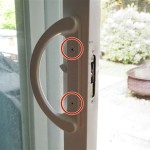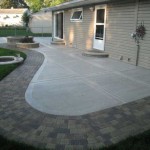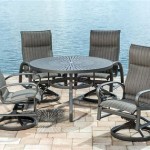Rectangular Patio Table Cover: Protecting Your Outdoor Investment
Outdoor furniture, particularly patio tables, represents a significant investment for homeowners and businesses alike. Exposure to the elements, including sun, rain, wind, and snow, can accelerate the degradation of these investments, leading to costly repairs or premature replacements. A rectangular patio table cover serves as a protective barrier, shielding the table from environmental hazards and extending its lifespan. Understanding the various types of covers available, their benefits, and factors to consider when selecting one is crucial for maximizing protection and maintaining the aesthetic appeal of your outdoor space.
The primary function of a rectangular patio table cover is to defend the table against weather-related damage. Prolonged exposure to ultraviolet (UV) radiation from the sun can fade and weaken the table's finish, leading to discoloration and cracking. Rain and snow can seep into the table's material, causing warping, rotting (in the case of wooden tables), and rust (in the case of metal tables). Wind can carry debris, such as leaves, dirt, and twigs, which can scratch the surface and accumulate in crevices, fostering mold and mildew growth. A well-chosen cover mitigates these risks, preserving the table's structural integrity and appearance over time.
Beyond environmental protection, a rectangular patio table cover also safeguards against accidental spills and stains. Outdoor tables are often used for dining and entertaining, increasing the likelihood of food and beverage spills. A cover provides a barrier against these spills, preventing them from penetrating the table's surface and causing permanent stains. This is particularly important for tables made of porous materials, such as wood or concrete, which are more susceptible to staining. Furthermore, the cover protects against animal droppings, which can be difficult to remove and may contain harmful bacteria.
The market offers a wide array of rectangular patio table covers, each with its own set of features, materials, and price points. Understanding these differences is essential for selecting a cover that meets your specific needs and budget. Key considerations include the material of the cover, its size and fit, its resistance to various weather conditions, and its ease of use and maintenance.
Material Considerations for Rectangular Patio Table Covers
The material of a rectangular patio table cover is a primary determinant of its durability, weather resistance, and overall performance. Common materials include polyester, vinyl, canvas, and polyethylene, each with its advantages and disadvantages. Polyester is a popular choice due to its affordability, water resistance, and UV resistance. However, it may not be as durable as other materials in harsh weather conditions. Vinyl is a waterproof and relatively inexpensive option, but it can become brittle and crack in extreme temperatures. Canvas is a durable and breathable material, but it requires regular treatment to maintain its water resistance. Polyethylene is a lightweight and waterproof material, but it is not as breathable as other options and may trap moisture, leading to mold and mildew growth.
Within each of these categories, there are variations in quality and construction. For example, some polyester covers are treated with a water-resistant coating, while others are not. Similarly, some vinyl covers are reinforced with a fabric backing for added durability. Choosing a cover made of high-quality materials and constructed with reinforced seams and edges will ensure greater longevity and protection.
Breathability is another crucial factor to consider. While waterproof materials are essential for protecting against rain and snow, they can also trap moisture inside the cover, leading to condensation and the growth of mold and mildew. Breathable materials allow air to circulate, preventing moisture buildup and reducing the risk of damage. Some covers are designed with vents or mesh panels to enhance breathability. When selecting a cover, it's important to strike a balance between water resistance and breathability to optimize protection and prevent moisture-related problems.
UV resistance is also a vital characteristic, especially in regions with high sun exposure. Prolonged exposure to UV radiation can cause the cover material to fade, crack, and weaken over time. UV-resistant covers are treated with special coatings or made of materials that inherently block UV rays. These covers offer superior protection against sun damage, extending the life of both the cover and the patio table.
Ensuring Proper Fit and Size for Optimal Protection
A well-fitting rectangular patio table cover is essential for providing adequate protection. A cover that is too small will not fully protect the table from the elements, while a cover that is too large may be susceptible to wind and debris. To ensure a proper fit, it's crucial to accurately measure the dimensions of the table, including its length, width, and height. When taking measurements, it's important to consider any protruding features, such as legs or overhangs.
Most manufacturers provide size charts or guidelines to help customers select the appropriate cover size. It's generally recommended to choose a cover that is slightly larger than the table to allow for easy installation and removal. However, avoid selecting a cover that is excessively large, as it may not provide a snug fit and could be more vulnerable to wind damage. Some covers are equipped with adjustable straps, buckles, or drawstrings that allow for a more customized fit. These features can help to secure the cover in place and prevent it from being blown away by strong winds.
Consider the shape of the table when selecting a cover. While the focus is on rectangular tables, variations in shape may exist, such as tables with rounded corners or beveled edges. Look for covers specifically designed to accommodate these variations to ensure a snug and secure fit. Generic covers may not conform properly to the table's shape, leaving areas exposed to the elements. Some manufacturers offer custom-made covers that are tailored to the exact dimensions and shape of the table, providing the best possible protection.
Beyond the table's dimensions, also consider the height of the cover. A cover that is too short will not fully protect the table legs or base, while a cover that is too tall may drag on the ground, collecting dirt and debris. Choose a cover that extends to approximately the bottom of the table legs or base, providing adequate protection without dragging on the ground. Some covers are designed with vents or mesh panels near the bottom to allow for ventilation and prevent moisture buildup.
Maintenance and Care of Rectangular Patio Table Covers
Regular maintenance and care are essential for extending the lifespan of a rectangular patio table cover and ensuring its continued effectiveness. The specific maintenance requirements will vary depending on the material of the cover, but some general guidelines apply to most types of covers. Regular cleaning is crucial for removing dirt, debris, and contaminants that can degrade the cover over time. Use a soft brush or cloth to wipe down the cover with mild soap and water. Avoid using harsh chemicals or abrasive cleaners, as they can damage the cover's finish and reduce its water resistance. Rinse the cover thoroughly with clean water and allow it to air dry completely before storing it.
Inspect the cover regularly for any signs of damage, such as tears, punctures, or frayed seams. Repair any minor damage promptly to prevent it from worsening. Small tears can often be repaired with a patch kit or waterproof tape. Frayed seams can be reinforced with needle and thread. Ignoring minor damage can lead to larger problems, compromising the cover's ability to protect the table.
Proper storage is essential for prolonging the life of the cover when it is not in use. Store the cover in a clean, dry place, away from direct sunlight and extreme temperatures. Avoid folding the cover too tightly, as this can create creases and weaken the material. Instead, roll the cover loosely and store it in its original packaging or a breathable storage bag. Before storing the cover, ensure that it is completely dry to prevent mold and mildew growth. Consider using a desiccant packet to absorb any residual moisture.
Address any mold or mildew growth promptly. Mold and mildew can thrive in damp environments and can damage the cover material. To remove mold and mildew, use a solution of bleach and water (1 part bleach to 10 parts water) and scrub the affected areas with a soft brush. Rinse the cover thoroughly with clean water and allow it to air dry completely. Always test the bleach solution on a small, inconspicuous area of the cover before applying it to the entire surface.
Following these maintenance and care guidelines will help to keep your rectangular patio table cover in good condition, ensuring that it continues to provide effective protection for your outdoor furniture for many years to come.

Custom Size Square Rectangular Patio Table Cover

Rectangular Patio Table Cover Heavy Duty Waterproof Outdoor Furniture Set Com

Rectangle Patio Table Covers For Tables And Chairs

Custom Made Table Covers Waterproof

Outdoor Rectangular Dining Table Cover

Rectangular Outdoor Table Set Covers National Patio

Classic Accessories Veranda Water Resistant 48 Inch Rectangular Patio Coffee Table Cover Com

Patio Rectangular Dining Table Chair Set Cover
Outdoor Patio Furniture Cover Xlg Seating Group Costco

Classic Accessories Veranda 96 In L X 44 W 23 H Patio Rectangle Oval Table Cover 56 311 061501 Ec The Home Depot
Related Posts








